Anyone who knows Kimber knows it as a 1911 company. A company making metal-framed, hammer-fired, single-stack, 1911-format handguns and positioning themselves securely at the higher end of the non-custom market. Well, they’ve just broken the mold with the R7 Mako.
In the Rumble-hosted video embedded above (or click HERE to view it on Rumble), I went back to the range with the R7 to put a few more rounds through it on camera. Dan and I had already spent a day with the R7 at The Range at Austin putting the little carry Kimber through its paces with hundreds of rounds of mixed ammunition, including seven brands and styles of hollow points plus frangible, subsonic, and others.
Having proven itself to be a great shooter and fully reliable with everything we fed it, I then carried the R7 for the next couple of weeks in the Mission First Tactical IWB holster that Kimber loaned out with the gun.
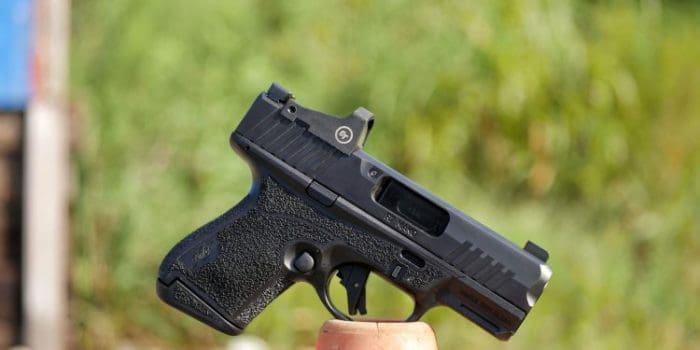
Three sentence review: I figured Kimber was going to hate my guts, because I opened the box and found the gun…aesthetically challenged (eye of the beholder and all that). After a week of envisioning a review more akin to an insult comic’s stand-up set, we hit the range with the R7 Mako and I no longer cared how this I’m-concealing-it-all-the-time-anyway micro-compact looked. It does all of the important stuff exceedingly well.
Now that Kimber only half hates me (joining a popular club), let’s hit on the first stand-out feature: the R7 Mako’s trigger. Clearly it had to be a darn good trigger if this new-world, polymer-framed, striker-fired Kimber was going to stand a chance in appealing to Kimber’s existing customer base. After all, these are guys and gals used to finely-tuned 1911 triggers, which basically set the standard for what a crisp, fantastic pistol trigger can be.
As you can see in the video, the R7 Mako trigger doesn’t disappoint. No, it isn’t a 1911 trigger, but it’s one of the best concealed carry, striker-fired triggers available. Right out of the box. It’s light — my sample measures right at 4.5 lbs with great consistency — it’s crisp, and it offers a short and pronounced reset.
I particularly appreciate that the trigger safety blade stops flush with the flat, straight face of the aluminum trigger, and that there’s no sponginess and almost no creep before the clean, crisp, and full break. Just a solid wall until 4.5 lbs of pressure is met, then a snap. It’s a really good trigger.
Of note: Kimber’s marketing material states a trigger pull weight of 5 to 6.75 pounds. My loaner, which to my understanding is a full production retail unit, is obviously measuring a bit under that range and it measures very consistently.
Perhaps the main feature that gives the R7 Mako aesthetics that stand out from the crowd is its ejection port. Rather than a large opening cut from near the bottom right side all the way up and across the top of the slide — often all the way into the chamfer between top and left side — as is the case with nearly all recoil-operated semi-automatic pistols, the R7’s ejection port is a smaller rectangular window that exists only within the right face of the slide.
Kimber says they did this for two main reasons:
One, it protects a mounted optic from gas and brass. This is certainly valid, as I’ve shot a lot of pistols with reflex sights on them and they absolutely do get carbon buildup and oil on the lens as it blows out of the ejection port. While I’ve never had a lens break due to an empty case impact, I’ve gotten some dings on the housing and I know it isn’t unheard of for this to be the cause of broken optics.
Two, it provides less area for dirt and other debris to enter the action. This can be a double-edged sword in some cases, but, sure, Kimber’s statement is objectively true.
The slide is a little taller than the more common design, as it has to live above the barrel hood rather than the barrel hood locking up flush with the top face of the slide.
The barrel does lock into the slide, it’s just accomplished with a lug on top of the barrel (not entirely unlike a 1911) rather than with the whole barrel hood itself.
This sort of pebbled, sandpaper-like texture has become very popular among polymer-framed pistols, and there’s good reason why. The texture is grippy and secure, yet isn’t as abrasive against your skin as one might expect, and it isn’t specific to any particular hand size or R/L handedness.
Unlike most micro-compact pistols, Kimber has molded nice palm swells into the R7 Mako’s grip. A curved bump graces both left and right sides ahead of the “Kimber” logo. It feels really good in the hand, and Kimber still does it with a stated 1.0-inch grip width, which is very svelte indeed.
Also appearing on both sides of the R7 are the magazine release and slide catch. Fully ambidextrous, not just swappable, each of these controls is equally functional from either side.
Field stripping the R7 is both familiar and unique at the same time. It starts as expected, with verification of an empty pistol followed by a trigger pull to decock the striker. Then, while pulling the slide rearward ever so slightly, pulling down on the disassembly catch by pinching it on each side and allowing the slide to move forwards.
This is where typical striker-fired disassembly similarity stops, though, along with the slide. In the photo above, the slide is shown as far forwards as it’ll go before the front and rear slide rails impact walls inside of the slide. Instead of continuing off the front of the frame, from here the user simply lifts the slide vertically right off the frame.
Reassembly, as you’d expect, is simply the reverse. Place the slide directly down onto the frame with the front and rear slide rails sliding up through their relief cuts underneath the slide, then rack the slide rearwards. The locking lug automatically re-engages and you’re ready to go.
One more item that jumped out at me as unique is the breach face. It’s a separately-machined component that slides down into the slide and is then pinned in place. Kimber says this was done for manufacturing efficiency. It does occur to me, though, that it will also make R7 Makos in other chamberings such as .40 S&W and .380 ACP an even easier effort for Kimber in the future, as well as make for fairly simple and inexpensive end user caliber swaps.
With its flush-fitting magazine, the R7 Mako holds an impressive 11+1 rounds.
Insert the extended magazine and you’re up to 13+1 rounds capacity with enough room for a pinky finger on the front strap. The aggressive inward curve at the heel helps prevent the Mako from printing when concealed.
You may have noticed, the Kimber in these photos is rocking a Crimson Trace reflex optic. The R7 comes in two flavors: Optics Ready ($599) or Optics Installed ($799). This guy’s the latter.
Both versions of the R7 Mako come equipped with Truglo Tritium Pro night sights. These are fantastic sights right out of the box.
Given the great sights, fantastic trigger, spot-on grip texture and ergonomics, and ambidextrous controls, there isn’t much for owners of the R7 to tinker with. There’s literally nothing that’s in need of an upgrade. This little pistol is extremely well-equipped and nicely tuned on day one.
That said, the accessory attachment point under the dust cover does have its limitations in that it appears lights and lasers will have to be designed specifically for the R7. No standard M1913 Picatinny rail here. Given the Crimson Trace optic, though, and Kimber’s work with CT in the past, I suspect lights and lasers and such are forthcoming.
On paper, the little Kimber is at the larger end of the P365, Hellcat, MAX-9, Shield Plus matchup. The R7 Mako is 4.3 inches tall (I measure 4.5 inches from the top of the rear sight straight down to the bottom-most part of the flush-fitting magazine’s baseplate), 6.2 inches long, 1.0 inch wide across the grip (my calipers peg it at 1.175 inches at the palm swell, 1.195 inches across the frame right by the slide stops, and 0.957 inches at the widest parts of the slide), and weighs 19.5 ounces according to Kimber (my scales say the Optics Installed model with an empty, 11-round magazine weighs 22.70 ounces). By way of comparison:
For whatever reason, when I first unboxed the R7 I thought it was a lot larger than its other micro-compact, “high-capacity” competitors listed above. It just looked bigger and handled bigger.
Some of that might be due to the taller slide. Some might be because of the extra few ounces, and some might be a result of the more palm-filling grip. On paper the difference is smaller than my first impression made it out to be.
Of course, it wasn’t long before I grabbed my SIG P365 and was surprised to see guns of such similar size.
Then, upon carrying the Mako, I was surprised once again by how easily it concealed and carried. It seems like the grip angle and how the web of the hand is moved forward under the slide a bit farther, the nicely rounded heel, and the somewhat unique footprint of it simply lended itself to easy IWB concealed carry. The R7 is still the largest and heaviest of these 10+ round micro-compacts, but it doesn’t necessarily carry like it.
On our first range outing with the Kimber R7 Mako, Dan and I had a clear mission. Having actually read the owner’s manual for once, I noticed that concerning blurb pictured above. I mean, this is a CCW pistol and it absolutely must run hollow point and other self-defense ammunition. Clearly. Zero star review right there on the spot if it doesn’t.
So we gathered a bunch of different hollow points representing various designs, with a couple absolute “flying ashtray” big mouth bullets in the mix, plus some frangible ammo and subsonic ammo and lightweight ammo and a little bit of everything else and we hit the range.
Zero issues. The R7 confidently and smoothly fed and fired absolutely everything we fed it.
Furthermore, it’s a great shooter. Surprisingly flat and fast, keeping the R7 precisely on target during rapid fire (and slow fire) was easy. I was able to track the front sight or the red dot without losing it under recoil.
Good ergonomics, grippy texture, that excellent trigger, quality sights, and a generally well-tuned recoil system all combine to make a really nice shooting gun. Especially for a sub-compact or micro-compact. Like the Shield Plus, the R7 Mako shoots and handles like a larger pistol than it is.
To be completely candid, the Kimber R7 Mako entered my review process starting way behind. Its aesthetics weren’t my cup of tea, and my initial impression was that it was too large to properly compete in this group. Plus, with the polymer frame, striker-fired format being such a departure for Kimber, I wasn’t confident it would gain any favor out on the range, either.
Turns out I was wrong. Not only does it stack up alright on its overall footprint, it conceals and carries beautifully and it excels on the shooting range. The Kimber R7 Mako is a fantastic concealed carry piece that’s fully equipped right out of the box, no upgrading or tinkering needed at all.
Specifications: Kimber R7 Mako
Caliber: 9mm
Capacity: 11+1 rounds flush fit, 12+1 extended
Barrel Length: 3.37 inches
Overall Length: 6.2 inches
Width As Measured: 1.175 inches at palm swell, 1.195 inches across slide stops, 0.957 inches across slide
Height As Measured: 4.5 inches
Weight As Measured: 22.7 ounces with optic and unloaded 11-round magazine
Sights: Truglo Tritium Pro steel sights front and rear. Optics Ready or Optics Installed (Crimson Trace CT-1500)
MSRP: $599 Optics Ready, $799 Optics Installed (find it at Brownells HERE)
Ratings (out of five stars):
Style and Appearance * *
I’m just not a fan. What can I say? Obviously this is very subjective.
Reliability * * * * *
We tested the R7’s ability to run nearly every sort of 9mm ammo out there, and it didn’t blink.
Ergonomics * * * *
Solid.
Customize This * * *
With great sights, an excellent trigger, and an optics cut (or included optic), it’s unlikely many owners will modify these things. Or even want to. However, aftermarket options for barrels, slides, triggers, sights, holsters, etc. won’t be quite as plentiful as with some other brands of pistols.
Overall * * * * ½
The Kimber R7 Mako is an extremely competitive micro-compact at a competitive price. It may be more Picasso than DaVinci, but “concealed means concealed” and the Mako truly shines where it counts.

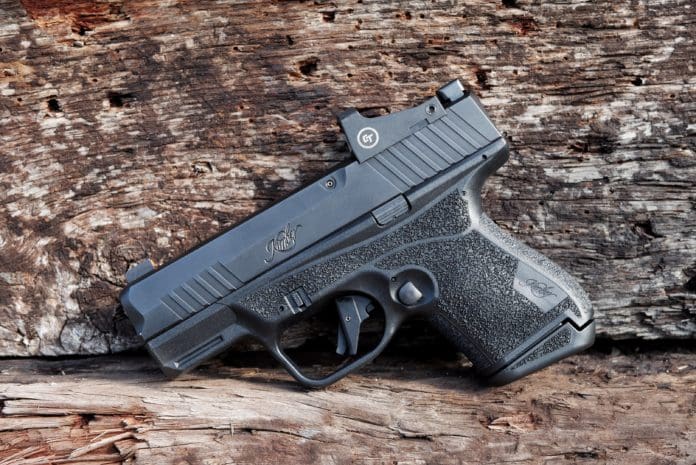

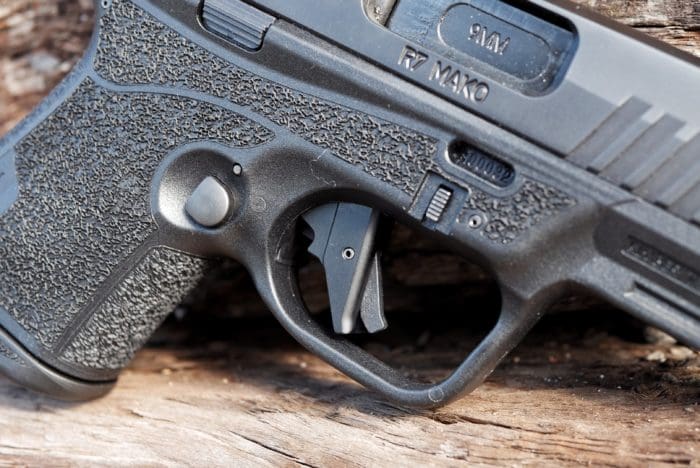
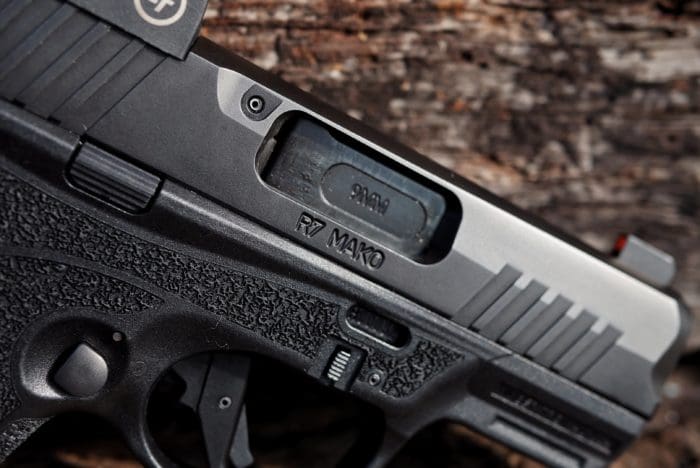

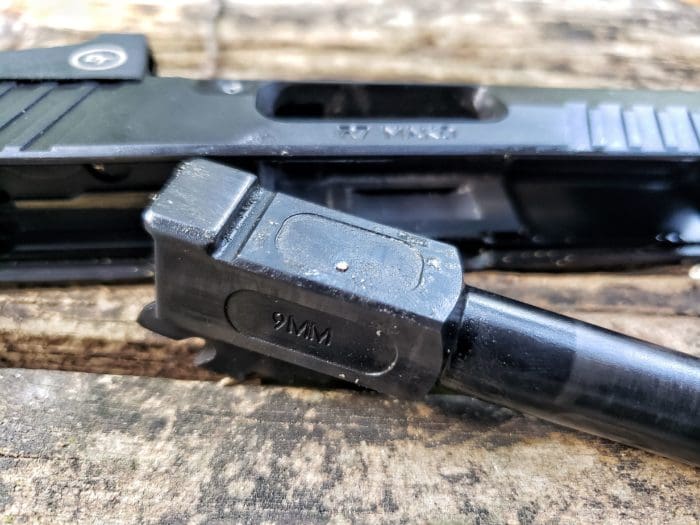
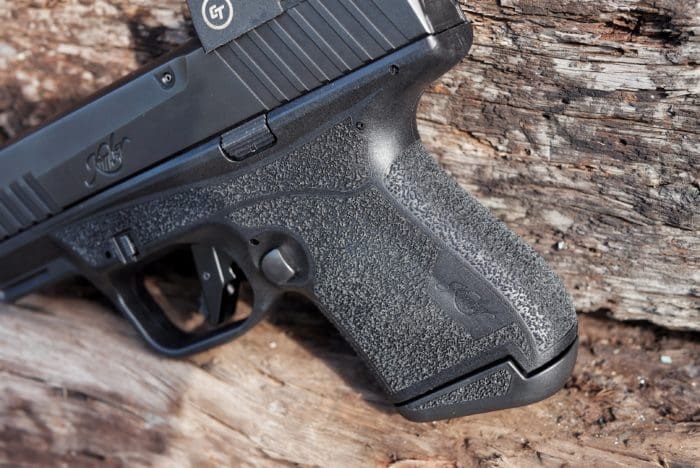



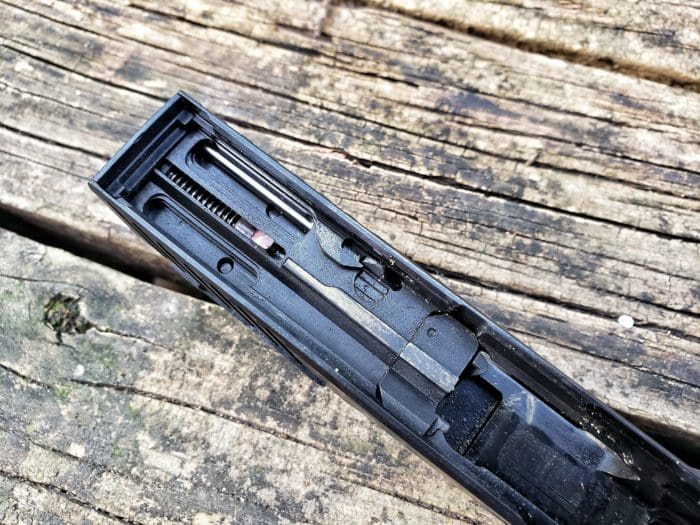

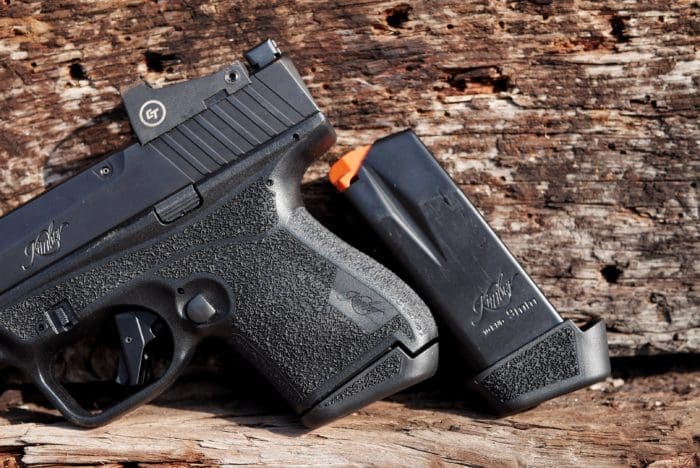
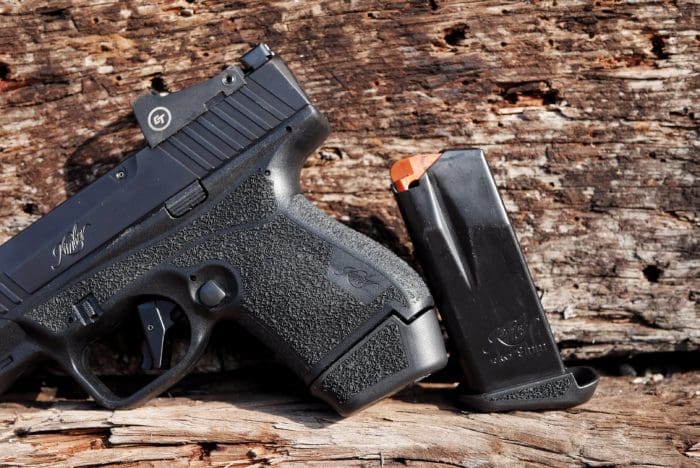
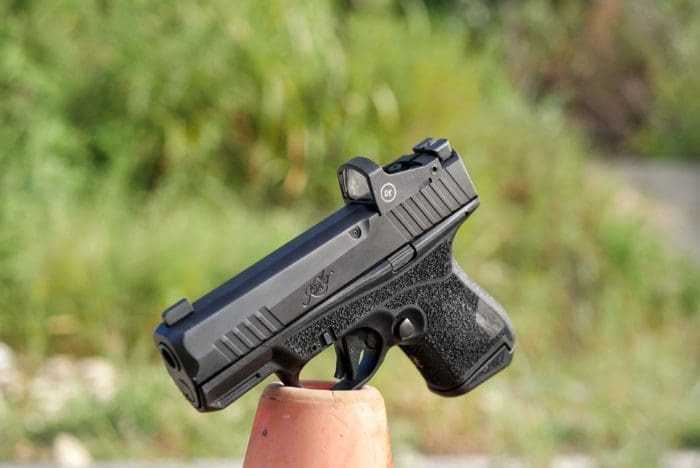
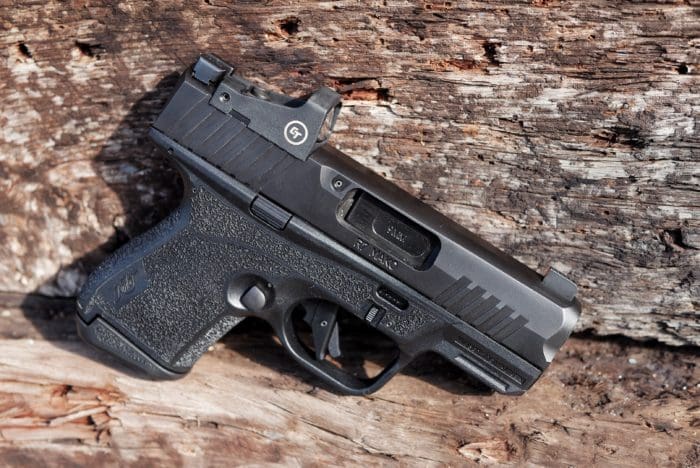
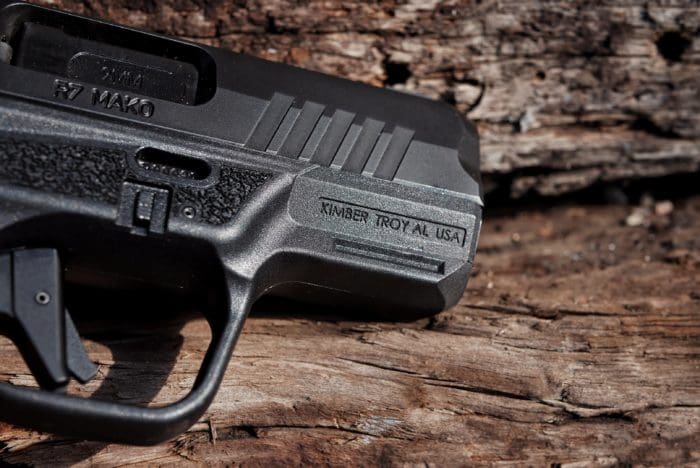
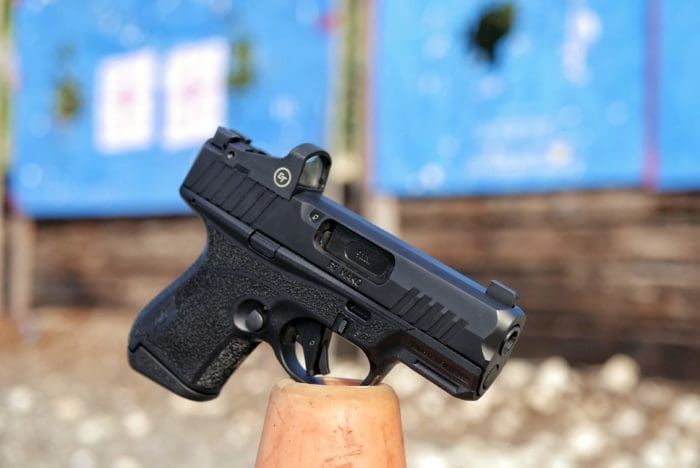
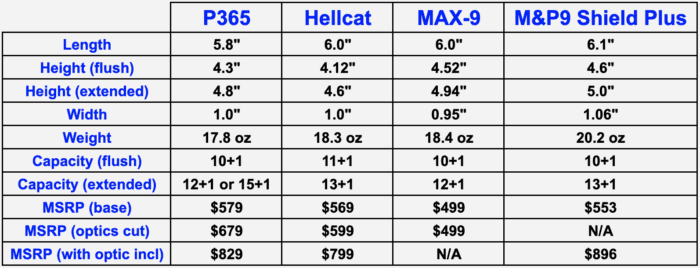
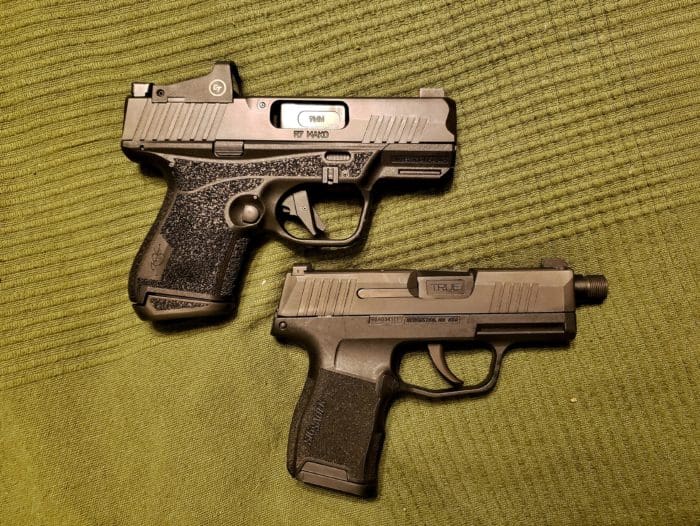
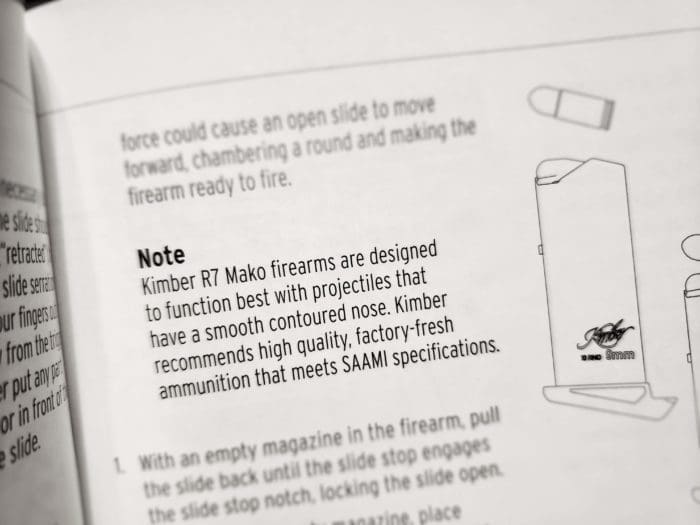




The difference may sound minor to some, but 1.195″ is thicker than a Glock 17 grip and much closer to a G21 or 2011 (made for FAT double-stack .45ACP) than a P-365.
Yeah, the Glock is 1.185″ but that’s the skinniest part of the grip (which is the majority of it). It’s 1.26″ at its widest. The R7 is also 1.185″ but only at the peak of the palm swells and the vast majority of it is skinnier (the 1″ that Kimber states). The 1.195″ stat is across that rib that goes along the slide stops and only right in front of and behind the slide stops where it’s at its widest. This is the same as a G19 across its slide stop. And the slide, of course, is quite a bit skinner (G19 is 1.07″).
Lots of points to compare, but generally speaking I’d say the Glock is mostly at this wider width with only a couple parts that are skinnier and the R7 is mostly at a skinnier width with only a couple parts that are wider.
(G21 is like 1.278″ wide for the majority of its grip)
I didn’t have my G23 here with me, so I went off Glock’s published figures. The Glock’s sides are mostly parallel / vertical at the narrower width.
The 2011’s 1.26″ was my own caliper reading at the thickest point; likewise for my P365 at .989″.
If your hand is calibrated to detect the difference in 1/100th of an inch in grip width difference…well then I guess you can nit-pick the difference, but I’m not sure it’s really worth trying to make a point over. Seems like a lot of non-Glock manufacturers are coming out with better stock products than Glock lately! And with pricing that isn’t too much different, especially when considering the cost of upgrading a stock Glock to where the competitors start at.
It certainly may compare in length, width, and height but the section on the frame above the trigger guard looks much thicker. In the p365 comparison, it appears that the p365 has quite a bit more grip area under the trigger guard. But I’m just going on the picture.
The Mako’s widest point is right in front of and behind the slide stops (1.195″). It’s an inch thick on the frame above the trigger guard and for basically all the rest of it except for the little palm swells and the rib by the slide stops.
Yeah, of all of these micro-compact guns the P365 stands out in the length of its front strap. https://www.thetruthaboutguns.com/heads-up-p365-vs-hellcat-vs-max-9-vs-mp9-shield-plus/
Sorry, didn’t mean in width. I meant the height of the frame in between the trigger guard and slide.
Ah, werd. Yeah if you look at the height of the trigger itself compared to where the web of your hand is or to the bore or whatever, it’s very different. It’s surprising, actually, that you can change this height so much and have a comfortable gun to shoot in both cases.
Looks a bit longer barrel than other micro 9’s. Universally good reviews on YouTube. Cheaper than I exected! Nice review…
3.37″. Longer than some, shorter than others.
It looks like a cross between a Springfield XD and a Taurus.
Still no microstamping? No Calfornia sales for you! (Even without microstamping, no external safety is a big no no also.)
Kimber for self defense…. no thanks. Any kimber I’ve ever shot could not finish a mag without failure.
I have had two for years and never had a problem.
Never have seen anyone at the range with a problem.
May be an old 90s thing.
Not exactly ditto to John, I had one that after shooting for a bit refused to return to battery. Tried everything, including a return to Kimber, No luck. Then I bought it a nice new Wolff spring and the problem was solved.
I have no problem with Kimber. We have 3 of them, including the much derided Solo. The Solo CDP had reliability issues but we finally figured out it was magazine related. After some experimentation with the mags it’s running perfectly. The other 2 Kimber’s have never had issues.
did i miss something? the only thing that matters is how well it shoots. can it even hit the paper at 25 yards?
So the gun is at fault if you miss the paper at 25 yards?
So far from the reviews I’ve seen so far the gun has been very accurate. If you miss at 25 yards it won’t be the guns fault.
Being an old guy, I’ve always preferred single, rotating takedown levers- I never liked the takedown “tabs”. Well, after having a thumb and pinky finger amputated- takedown “tabs” irritate the hell out of me. Simply rotating one lever down is so… easy. Why make things so much harder than they have to be?!
But, overall the R7 looks promising… for folks who don’t have a hate hard-on for Kimber.
I’m not the kind of fanboy who thinks everything about the 1911 is perfect or that pistol evolution culminated back then, but its takedown is pretty close.
One simple component stops and releases the slide, includes its own pivot pin, guides the barrel into and out of battery, holds it into the frame, and has its own big, can’t-miss handle for field-stripping. In what way is any “modern” system better than that?
Umm… Absodamnlutely!
The ONLY pistols I have trouble disassembling are the ones with the inane tabs. Yay technology!… NOT.
Peter Gunn,
Exactly! I can understand making the pin and lever separately, but that’s about it. It’s amazing how many designers of modern, “simplified” pistols with the “minimum” number of parts chose to replace this stroke of genius with 4-7 parts (some fairly complex).
Oh, and the geniuses that make takedown pins requiring punches, when JMB simply made it stick out a little bit!
Yep- complicated is easy… simple is hard.
John Moses Browning = Genius.
I’m wandering a bit off the original topic, but you’ve reminded me of a big pet peeve.
People like to act like “change” is hard, but implementing good new ideas (or even bad new ideas) is easier than killing bad new ideas. There is no easy way to tell a boss, company, etc. that their “innovation” is dumber than the old product or process in every possible way. It gets worse when you’ve been in an organization for a while, and the “new idea” is a rehash of something that was conclusively proven worthless twelve years ago.
Ah, yes… the lamentable ideology of “innovation” with the exclusive objective of job security. If your design is too good- you won’t be given the opportunity to “fix it” for additional money down the road. And the digital revolution has ushered in a whole new world of engineers worshiping at the altar of planned obsolescence.
Pathetic, really. But, unfortunately… par for the course.
I agree, I hate when guns require pulling the two tabs down for disassembly. My G21 is real fiddly pain in the butt to get it just right.
But when are they coming out with the rainbow colored slide version?
Hopefully soon.
I like the full body stippling – going where it’s actually needed.
I’ve had brass eject from my Staccato C into my Romoe0 and shatter the lens. Clever little ejection port on this gun (if its reliable).
Jeremy:
I was going to fix your comparison chart by inserting a MAKO column, and I did. But… This website won’t allow me to insert it as a .jpeg file into this comment. It WOULD be nice, though.
Otherwise, nice review.
Ah, thanks! Obviously something I should have done. Blast it on over to [email protected] if you’re so inclined 🙂
Done!
Was there a particular load that worked best? Accuracy wise perhaps as it sounds like it ate and spit out everything you gave it. Cheers
No, I didn’t do formal accuracy testing with multiple loads. It’s a tight shooter and keeping it centered on the paper at 25 yards passes the accuracy test. For a little CCW gun I’ve stopped doing official, on-a-gun-rest, multiple-types-of-ammo accuracy testing. I’m more concerned with how easy it is to keep on target during rapid fire at 7 yards than whether it groups 1.5″ or 2.5″ at 25 yards off a rest or if ammo A makes 1.5″ groups and ammo B makes 1.8″ groups (P.S. if ammo C puts up 3″ groups but is the best self-defense ammo I’m carrying ammo C.). For a precision rifle or a target pistol? Sure, we do the accuracy testing. For a CCW micro-compact, we just don’t do it anymore as it’s not particularly relevant.
” it provides less area for dirt and other debris to enter the action. This can be a double-edged sword in some cases,”
Okay, I admit I don’t know a whole lot about guns. I know the 4 rules, I know how to sight in a rifle, and I know which end the bullets come out of. Why is this a doubled edged sword to not let dirt in?
One school of thought is try to seal things off to keep them clean. The other is to leave openings and windows to let the inevitable crud out. The debate is similar RE tight tolerances or loose tolerances. Sometimes guns will effectively feature ‘self-cleaning’ ports where the action drives debris to an exit point. Clearly you don’t want dirt to get in, but at the same time if dust, dirt, flakes of brass, unburned powder, lint, water, etc does get in there, you don’t want to trap it in there.
. . . which, by the way, is the reason for that huge empty space and open bottom at the back of a Glock grip–you know, the one that people insist on plugging up with cutesy little thingies to hold an extra cartridge, or a punch, or a small snack for those slack times at the range, or during a lull in the gunfight when one is feeling peckish.
It’s also the reason for the hole just ahead of the trigger guard loop on a Remington fire-control assembly, put there to hopefully allow bits and pieces to fall free before clogging up the trigger/sear mechanism and letting the gun fire without a trigger pull, whether or not the safety is engaged.
Dirt (and ‘things’) will ALWAYS get in; Not letting it back out tends to be a mistake.
This is Wilhelm Bubit’s gun first appeared in Austria as BB6, then in Brazil as Taurus TS9C and now in the US as Kimber… The gun got eye pleasing changes at each owner resulting current shape without manual pedal safety lever.
The gun follows closely “Glock” trigger action with purposedly complicated part shapes and location…
Take down process the gun uses, was first used in “Mauser HSc” pistols and then “Vz 52”…
Most notable “Bubits” feature should be “Locking lug at top end of the barrel” providing low unlocking angle…
English is not your first language, ‘m thinking, but you did a good job–especially the second paragraph where you point out that this is a Glock that has been ‘purposedly complicated part shapes and location. . .’
Couldn’t of summed it up better myself.
Great comment, I’d never even heard of the BB6.
I’ve got a Steyr L9-a1 that he also designed. They are a neat gun, but the hump in the grip hurts my palm when I shoot the gun. I’ll have to try one of the new ones with interchangeable back straps one of these days.
That optic looks like a heap of hot garbage – can’t find any consistent numbers on the battery life either but it appears that it’s measured in the hundreds of hours – which means less than a month.
And it goes off when it’s dark – so if it’s dark outside you have no sights and you get to die.
IIRC it’s rated for 20k hours (2 years plus) and it doesn’t turn off when it’s dark. Like the Shield RMS and JPoint and SIG version of extremely similar (if not internally identical) designs, the optic automatically and very appropriately adjusts brightness based on ambient conditions and isn’t off unless it is legit 100% completely dark, basically meaning you’ve put the cover on. I’ve carried and used the Shield and JPoint versions for many years and they work great in a totally dark house at night.
Of course, there are optics with manual brightness adjustments that fit this same footprint and obviously you could buy the Optics Ready flavor of the pistol and put something else on it.
Had 2 Kimbers, shot over a dozen others… never made it through a mag without an issue. No thanks. Have had better experience with Taurus and even hipoints.
The Kimber R7 Mako is similar to the Glock 26 in size and weight, so it’s a new subcompact 9mm, not a viable competitor in the pocket 9 market and doesn’t at all compare to significantly smaller & lighter micro 9mm pistols like the game changing Sig P365 & Springfield Hellcat.
I was gonna ask what you didn’t like about the appearance, until I saw the pic of it with the P365. Then I said “Oh…okay”. Perspective is everything.
The P365 is the kinda cute girl and the R7 is her awkward fat friend that she hangs out with to feel better about herself.
Curious why they made the magazine clip capacity 11. This would be a felony gun in most states in the Northeast, California, Washington and Hawaii. The Second Amendment only goes up to 10 in a lot of areas in this country. Could have just made it hold ten and it wouldn’t be considered an assault weapon. This would definitely cut into their sales quite a bit. Who wants to be a cuck in one of those states and use specialty 10 round clips?
Jeremy, How does the grip compare, circumference and length from front to back, to the Hellcat, the 365 or the XDs. From what I can tell it is most like the XDs. Personally I like the XDs. The others feel like holding a hammer. Thanks
It’s a Kimber, buy something else.
They used to make quality guns.
That stopped in 2010.
Bad QC, worse CS and poorly made guns.
They are relying on their old reputation.
The R7 looks cheap and is probably 50% MIM.
This is a $225 gun priced at $600.
It could have serious durability issues.
Gee Bill. I did ask a specific question, but you responded with something completely different. Turned out to be a waste of my time to read your response. If you have a bitch about Kimber, why not start your own thread?
I’m actually trying to help you.
Kimber is not what it used to be at all.
Go to a LGS and try out different guns.
You’ll probably end up with a M&P9 Shield Plus.
Jeremy’s tests are only a taste.
The best way to determine if a gun is for you is to shoot it.
Also do you know when a gun just plain sucks?
When it gets bashed on it’s manufacturers fanboy forum.
The R7 Mako is closer to a compact gun in its grip circumference and overall feel in the hand. It fills the palm more than a Hellcat and much more than a P365. But it’s still far from Glock 19. It’s somewhere in the middle and it’s nice and ergonomic. It feels good in the hand.
As for Bill’s comments, obviously Kimber had a period of dodgy reliability that earned it that reputation, but we ran the R7 hard and with challenging ammo and it’s a champ. All other reviews (from what I’ve heard…I’ve only watched/read a couple) are also highly positive, apparently, and I haven’t seen any reports of any issues at all other than knocks on its homeliness. I also have a new production Rapide Black Ice in 9mm and it has run like a sewing machine and is a well-made, super smooth pistol. I did have a K6 revolver that wasn’t accurate, but if it matters that was one of the first ones off the line and it was quite a few years ago.
Did I mention anything about buying one? I just asked about the size of the grip. And, FYI I know how to find a firearm that works well for me. And I will not buy one without handling it first. I am in no rush because I am happy with what I already have. Your original post mentioned nothing about giving friendly advice. Your original post seemed like a lot of griping. I see that on a lot of subjects, so most often I pay little attention to the haters. I suggested you start your own thread. I still feel that way. Now if you can answer my question about the size of the grip, well then go right ahead and answer. That is the information I am interested in.
Have you gone on YouTube? The answer might be in one of the reviews.
Kimber passed out a lot the R7 Makos for testing.
There are easily 20 reviews of this gun on there.
Kimber is really trying to roll this one out so that might be your best bet.
I usually carry something a bit larger or smaller depending on what I’m wearing.
I may also have a revolver for a back up, I’m not a one size fits all type.
Hi Bill, Now we are having a conversation with some merit. Yes I have seen a bunch of the Youtube videos. Everyone seems to give the R7 great praise. As I stated in my first posting I think the Hellcat and the 365 have grips that feel too small and too round. I do like my XDs. I wonder if SA will come out with an XDs Mod 3 optics ready with increased capacity. While the current trigger isn’t bad, it could be better. As far as I can tell the R7 is very close in size to the XDs. That is why I would be interested in checking one out, but I am in no rush to spend for one. I’ll just change mags as I need to.
Thanks Jeremy, Taking a side shot of the R7 on the computer and getting the slide length in the photo to as close to the stated length, I was able to overlay my Springfield XDs. The grip on the R7 appears just slightly smaller from front to back. Maybe an 1/8 inch difference. I was trying to confirm that observation. I have a couple of Kimber 1911’s from 2008 and earlier. Both work well. All of the reviews I saw on the R7 were like yours, very favorable, but none had the grip dimension. One just may make it under the Xmas tree. Thanks for your reply.
Gun Review: Kimber R7 Mako 11 1 Round Micro-Compact – The Truth About Guns
[url=http://www.g732fs1r5gqnj179r2ywoj2j810316zgs.org/]udcntbybnbw[/url]
adcntbybnbw
dcntbybnbw http://www.g732fs1r5gqnj179r2ywoj2j810316zgs.org/
If you love to wear action movies and games outfits so must check the top 5 superb Cosplay Jackets which gives you a killer and stunning look on this cosplay festival.